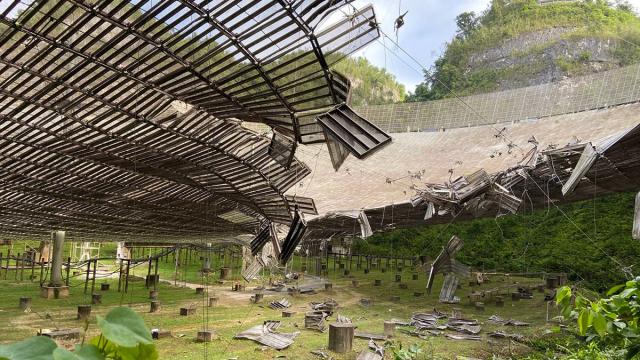The Arecibo Observatory in Puerto Rico is currently out of commission after a thick support cable fell onto the dish, creating a large gash. It’s yet another setback for the beloved science facility, which hasn’t fully recovered from the devastation of Hurricane Maria.
At around 2:45 a.m. local time on Monday August 10, a three-inch thick auxiliary cable fell onto the observatory’s main reflector dish, creating a 30.48 m-long scar, reports UCF Today. The cable is used to support a metal platform above the observatory. All scientific work done at the Arecibo facility is on pause, pending repairs. The cause of the cable failure is not yet known, nor is cost or time required for the fixes.
Around a half-dozen panels on the Gregorian Dome were also damaged when the cable fell, as was a platform used to access the dome. The Gregorian Dome, which rests some 152 metres above the surface of the dish, houses a multi-beam receiver capable of scanning multiple points in the sky simultaneously.
Francisco Cordova, the director of the observatory, told UCF Today that a team of experts is assessing the situation and that the current focus is “assuring the safety of our staff, protecting the facilities and equipment, and restoring the facility to full operations as soon as possible, so it can continue to assist scientists around the world.”
Gizmodo reached out to Arecibo Observatory officials for more information and will update this post should we hear back.
Constructed in 1963, the Arecibo Observatory, with its 304.80 m-wide disk, is one of the most powerful radio telescopes on Earth, second only to China’s Five-hundred-metre Aperture Spherical Radio Telescope, or FAST. At Arecibo, scientists conduct all sorts of work, from atmospheric and planetary science through to radio and radar astronomy and even searches for extraterrestrial intelligence, also known as SETI. On Tuesday, the official Twitter account for the SETI Institute tweeted out a picture of the damage simply captioned: “We have no words.”
Abel Méndez, director of the Planetary Habitability Laboratory at the University of Puerto Rico at Arecibo, said his team’s science observations and many others will be delayed.
“We finished last week observing Barnard’s Star,” explained Méndez in an email. “We still need to observe other stars, including some with potentially habitable planets, in the following months.”
The purpose of these observations are to determine the ways in which red dwarf stars, like Barnard’s Star, affect the habitability of their planets. Méndez was also planning to embark on a SETI project to detect extraterrestrial technosignatures (i.e. evidence of alien technology), which would have leveraged both past and future observations at Arecibo. All this now appears to be on hold.
Méndez’s observations aren’t time critical, but others might be, including scans for potentially dangerous nearby asteroids.
This latest incident comes less than three years after Hurricane Maria ravaged Puerto Rico. The storm caused relatively minor damage to the Arecibo Observatory, but repairs have yet to be completed. The facility has also been wracked with fiscal uncertainty. The U.S. National Science Foundation recently decreased its annual funding from $US8.2 ($11) million to $US2 ($3) million, with private backers such as Yang Enterprises making up the shortfall.
The future of this important facility was starting to look brighter, but its prospects are once again in peril.
